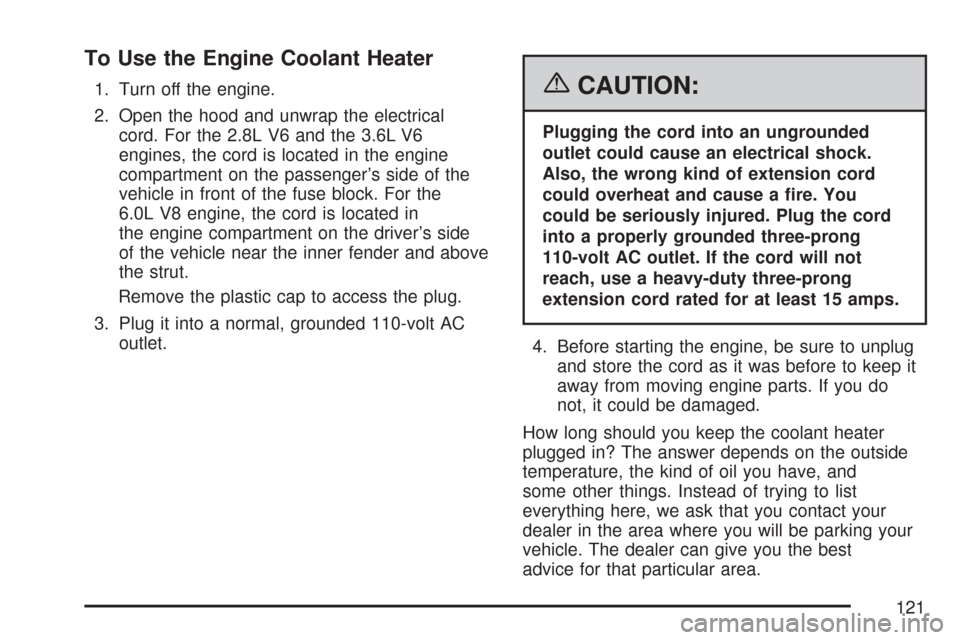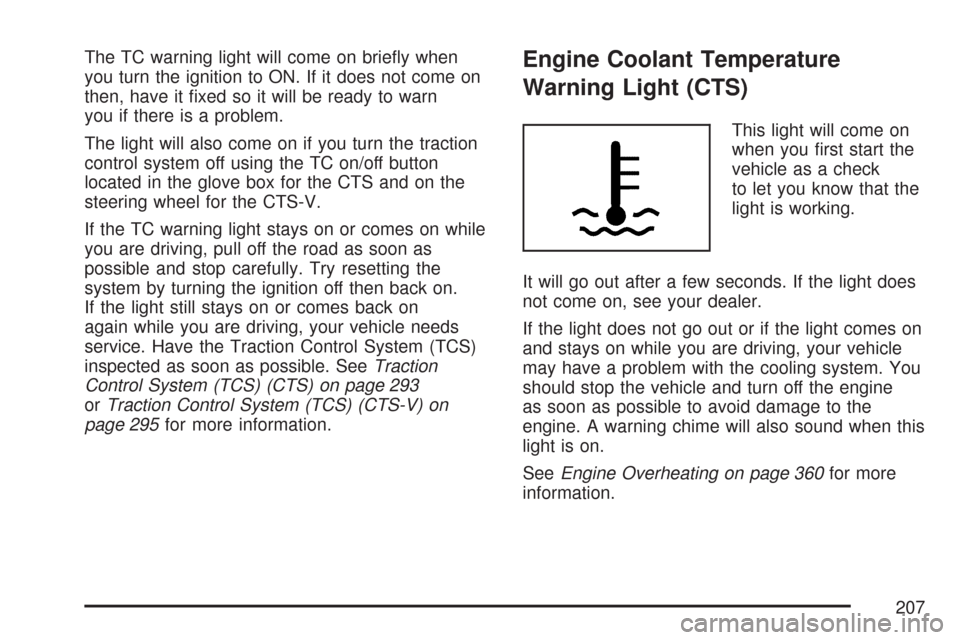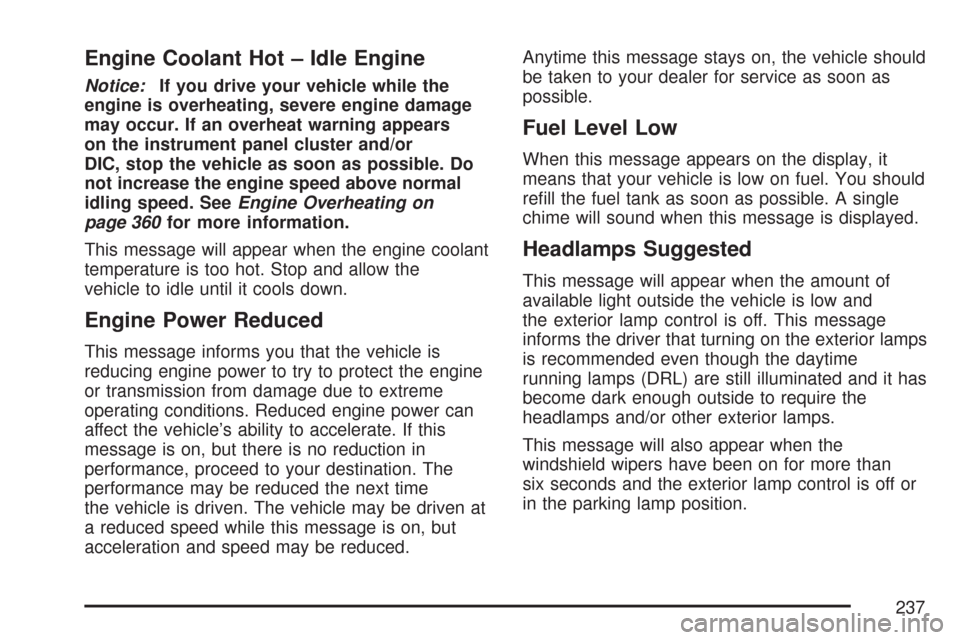engine overheat CADILLAC CTS 2007 1.G Owners Manual
[x] Cancel search | Manufacturer: CADILLAC, Model Year: 2007, Model line: CTS, Model: CADILLAC CTS 2007 1.GPages: 518, PDF Size: 2.77 MB
Page 121 of 518

To Use the Engine Coolant Heater
1. Turn off the engine.
2. Open the hood and unwrap the electrical
cord. For the 2.8L V6 and the 3.6L V6
engines, the cord is located in the engine
compartment on the passenger’s side of the
vehicle in front of the fuse block. For the
6.0L V8 engine, the cord is located in
the engine compartment on the driver’s side
of the vehicle near the inner fender and above
the strut.
Remove the plastic cap to access the plug.
3. Plug it into a normal, grounded 110-volt AC
outlet.{CAUTION:
Plugging the cord into an ungrounded
outlet could cause an electrical shock.
Also, the wrong kind of extension cord
could overheat and cause a �re. You
could be seriously injured. Plug the cord
into a properly grounded three-prong
110-volt AC outlet. If the cord will not
reach, use a heavy-duty three-prong
extension cord rated for at least 15 amps.
4. Before starting the engine, be sure to unplug
and store the cord as it was before to keep it
away from moving engine parts. If you do
not, it could be damaged.
How long should you keep the coolant heater
plugged in? The answer depends on the outside
temperature, the kind of oil you have, and
some other things. Instead of trying to list
everything here, we ask that you contact your
dealer in the area where you will be parking your
vehicle. The dealer can give you the best
advice for that particular area.
121
Page 131 of 518

Leaving Your Vehicle With the Engine
Running (Automatic Transmission)
{CAUTION:
It can be dangerous to leave your vehicle
with the engine running. Your vehicle could
move suddenly if the shift lever is not fully
in PARK (P) with the parking brake �rmly
set. And, if you leave the vehicle with the
engine running, it could overheat and even
catch �re. You or others could be injured.
Do not leave your vehicle with the engine
running.
If you have to leave your vehicle with the engine
running, be sure your vehicle is in PARK (P)
and your parking brake is �rmly set before you
leave it. After you have moved the shift lever into
PARK (P), hold the regular brake pedal down.
Then, see if you can move the shift lever
away from PARK (P) without �rst pushing the
button on the shift lever. If you can, it means that
the shift lever was not fully locked into PARK (P).
Torque Lock (Automatic Transmission)
If you are parking on a hill and you do not shift your
transmission into PARK (P) properly, the weight of
the vehicle may put too much force on the parking
pawl in the transmission. You may �nd it difficult to
pull the shift lever out of PARK (P). This is called
“torque lock.” To prevent torque lock, set the
parking brake and then shift into PARK (P) properly
before you leave the driver’s seat. To �nd out how,
see “Shifting Into PARK (P)” listed previously.
If torque lock does occur, you may need to have
another vehicle push yours a little uphill to
take some of the pressure from the parking pawl
in the transmission, so you can pull the shift
lever out of PARK (P).
131
Page 207 of 518

The TC warning light will come on brie�y when
you turn the ignition to ON. If it does not come on
then, have it �xed so it will be ready to warn
you if there is a problem.
The light will also come on if you turn the traction
control system off using the TC on/off button
located in the glove box for the CTS and on the
steering wheel for the CTS-V.
If the TC warning light stays on or comes on while
you are driving, pull off the road as soon as
possible and stop carefully. Try resetting the
system by turning the ignition off then back on.
If the light still stays on or comes back on
again while you are driving, your vehicle needs
service. Have the Traction Control System (TCS)
inspected as soon as possible. SeeTraction
Control System (TCS) (CTS) on page 293
orTraction Control System (TCS) (CTS-V) on
page 295for more information.Engine Coolant Temperature
Warning Light (CTS)
This light will come on
when you �rst start the
vehicle as a check
to let you know that the
light is working.
It will go out after a few seconds. If the light does
not come on, see your dealer.
If the light does not go out or if the light comes on
and stays on while you are driving, your vehicle
may have a problem with the cooling system. You
should stop the vehicle and turn off the engine
as soon as possible to avoid damage to the
engine. A warning chime will also sound when this
light is on.
SeeEngine Overheating on page 360for more
information.
207
Page 208 of 518

Engine Coolant Temperature Gage
This gage shows the
engine coolant
temperature. If the gage
pointer moves into
the shaded area, the
engine is too hot.
That reading means the same thing as the
warning light – the engine coolant is very hot.
SeeEngine Overheating on page 360.
Tire Pressure Light (CTS-V Only)
If the vehicle has the
Tire Pressure Monitor
System, this light
will come on if the
system detects low
tire pressure.
This light will also come on for a bulb check when
the vehicle is started.
SeeTire Pressure Monitor System on page 405
for more information.
For more information on the proper tire pressure,
seeLoading Your Vehicle on page 321. For
more information on your tires, seeTires on
page 392.
208
Page 216 of 518

Speedometer Display
This display will show information relating to
vehicle speed, odometer, and transmission status.
The information displayed can be changed by
pressing (C). Pressing this button cycles the
displayed information as follows: digital
speedometer only, odometer only, speedometer
and odometer, or blank display.
When the transmission is shifted into
REVERSE (R), an R will appear in the
upper right corner.
During slow speed maneuvers, the engine’s
computer may command the transmission to
engage the Skip Shift feature. For more
information seeManual Transmission Operation
on page 126.
Tachometer Display
Press (B) to cycle through the following displays:
coolant temperature, oil pressure, oil temperature,
transmission temperature, tire pressure, and
lateral acceleration. Press (A) to cycle through the
displays in reverse order. If you press (A), for
about one second, the display will become blank.
Coolant Temperature
When the coolant
temperature displays
you will see the coolant
temperature symbol.
The temperature displays in degrees Fahrenheit or
Celsius with a graph beneath the reading. If the
graph shows the temperature in the shaded
area all the way on the right, then the coolant
temperature is hot. SeeEngine Overheating
on page 360for more information.
216
Page 237 of 518

Engine Coolant Hot – Idle Engine
Notice:If you drive your vehicle while the
engine is overheating, severe engine damage
may occur. If an overheat warning appears
on the instrument panel cluster and/or
DIC, stop the vehicle as soon as possible. Do
not increase the engine speed above normal
idling speed. SeeEngine Overheating on
page 360for more information.
This message will appear when the engine coolant
temperature is too hot. Stop and allow the
vehicle to idle until it cools down.
Engine Power Reduced
This message informs you that the vehicle is
reducing engine power to try to protect the engine
or transmission from damage due to extreme
operating conditions. Reduced engine power can
affect the vehicle’s ability to accelerate. If this
message is on, but there is no reduction in
performance, proceed to your destination. The
performance may be reduced the next time
the vehicle is driven. The vehicle may be driven at
a reduced speed while this message is on, but
acceleration and speed may be reduced.Anytime this message stays on, the vehicle should
be taken to your dealer for service as soon as
possible.
Fuel Level Low
When this message appears on the display, it
means that your vehicle is low on fuel. You should
re�ll the fuel tank as soon as possible. A single
chime will sound when this message is displayed.
Headlamps Suggested
This message will appear when the amount of
available light outside the vehicle is low and
the exterior lamp control is off. This message
informs the driver that turning on the exterior lamps
is recommended even though the daytime
running lamps (DRL) are still illuminated and it has
become dark enough outside to require the
headlamps and/or other exterior lamps.
This message will also appear when the
windshield wipers have been on for more than
six seconds and the exterior lamp control is off or
in the parking lamp position.
237
Page 320 of 518

You will need a well-charged battery to restart the
vehicle, and possibly for signaling later on with
your headlamps. Let the heater run for a while.
Then, shut the engine off and close the window
almost all the way to preserve the heat. Start
the engine again and repeat this only when you
feel really uncomfortable from the cold. But do it as
little as possible. Preserve the fuel as long as
you can. To help keep warm, you can get out of
the vehicle and do some fairly vigorous exercises
every half hour or so until help comes.
If Your Vehicle is Stuck in Sand,
Mud, Ice, or Snow
In order to free your vehicle when it is stuck, you
need to spin the wheels, but you do not want
to spin the wheels too fast. The method known as
rocking can help you get out when you are
stuck, but you must use caution.
{CAUTION:
If you let your vehicle’s tires spin at high
speed, they can explode, and you or
others could be injured. And, the
transmission or other parts of the vehicle
can overheat. That could cause an engine
compartment �re or other damage. When
you are stuck, spin the wheels as little as
possible. Do not spin the wheels above
35 mph (55 km/h) as shown on the
speedometer.
Notice:Spinning the wheels can destroy parts
of your vehicle as well as the tires. If you
spin the wheels too fast while shifting
the transmission back and forth, you can
destroy the transmission.
For information about using tire chains on your
vehicle, seeTire Chains on page 418.
320
Page 329 of 518

Service........................................................ 332
Accessories and Modi�cations................... 332
California Proposition 65 Warning.............. 333
Doing Your Own Service Work.................. 333
Adding Equipment to the Outside of
Your Vehicle.......................................... 334
Fuel............................................................. 334
Gasoline Octane........................................ 334
Gasoline Speci�cations.............................. 335
California Fuel........................................... 335
Additives................................................... 336
Fuels in Foreign Countries........................ 336
Filling the Tank......................................... 337
Filling a Portable Fuel Container............... 339
Checking Things Under the Hood.............. 340
Hood Release........................................... 341
Engine Compartment Overview.................. 342
Engine Oil................................................. 346
Engine Oil Life System.............................. 349
Engine Air Cleaner/Filter............................ 351
Automatic Transmission Fluid.................... 353
Manual Transmission Fluid........................ 354Hydraulic Clutch........................................ 356
Engine Coolant.......................................... 356
Coolant Surge Tank Pressure Cap............ 360
Engine Overheating................................... 360
Overheated Engine Protection
Operating Mode..................................... 362
Cooling System......................................... 363
Power Steering Fluid................................. 368
Windshield Washer Fluid........................... 369
Brakes...................................................... 371
Battery...................................................... 375
Jump Starting............................................ 376
Rear Axle.................................................... 382
Headlamp Aiming........................................ 383
Bulb Replacement....................................... 386
High Intensity Discharge (HID) Lighting..... 386
Halogen Bulbs........................................... 386
Front Turn Signal and Fog Lamps............. 387
Taillamps, Turn Signal, Stoplamps and
Sidemarker Lamps................................. 388
Back-Up and License Plate Lamps............ 389
Replacement Bulbs................................... 389
Section 5 Service and Appearance Care
329
Page 354 of 518

To reset the transmission �uid life indicator, use the
following steps:
1. Press the up or down arrow on the INFO
(Information) button located to the right of the
DIC display to access the DIC menu.
2. Once the XXX% TRANS FLUID LIFE menu
item is highlighted, press and hold the CLR
button.
The percentage will return to 100, and the
transmission �uid life indicator will be reset.
3. Repeat the steps if the percentage does not
return to 100.
Navigation System
If your vehicle has a navigation system, see your
Navigation System Manual for instructions on
how to acknowledge the Change Trans Fluid
message and reset the transmission �uid
life indicator.
Manual Transmission Fluid
When to Check Manual Transmission
Fluid
It is not necessary to check the manual
transmission �uid level. A transmission �uid leak is
the only reason for �uid loss. If a leak occurs, take
the vehicle to your GM dealer service department
and have it repaired as soon as possible.
How to Check Manual Transmission
Fluid
Because this operation can be difficult, you may
choose to have this done at your GM dealer
service department.
If you do it yourself, be sure to follow all the
instructions here, or you could get a false reading.
Notice:Too much or too little �uid can damage
your transmission. Too much can mean that
some of the �uid could come out and fall on hot
engine parts or exhaust system parts, starting a
�re. Too little �uid could cause the
transmission to overheat. Be sure to get an
accurate reading if you check your
transmission �uid.
354
Page 356 of 518

Hydraulic Clutch
It is not necessary to regularly check clutch �uid
unless you suspect there is a leak in the system.
Adding �uid will not correct a leak.
A �uid loss in this system could indicate a
problem. Have the system inspected and repaired.
When to Check and What to Use
The hydraulic clutch
�uid reservoir cap has
this symbol on it.
SeeEngine
Compartment Overview
on page 342for
reservoir location.
Refer to the Maintenance Schedule to determine
how often you should check the �uid level in
your clutch master cylinder reservoir and for the
proper �uid to use. SeeOwner Checks and
Services on page 469andRecommended Fluids
and Lubricants on page 473.
How to Check and Add Fluid
Make sure the �uid level is at the MIN (Minimum)
line on the side of the reservoir. If it is not,
remove the cap and add the proper �uid until the
level reaches the MIN line.
Engine Coolant
The cooling system in your vehicle is �lled with
DEX-COOL®engine coolant. This coolant is
designed to remain in your vehicle for �ve years or
150,000 miles (240 000 km), whichever occurs
�rst, if you add only DEX-COOL
®extended
life coolant.
The following explains your cooling system and
how to add coolant when it is low. If you have
a problem with engine overheating, seeEngine
Overheating on page 360.
356